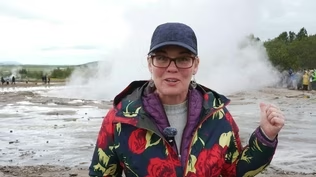But Why – A show for curious kids
How are glaciers formed?
8/15/2025 | 2m 29sVideo has Closed Captions
How are glaciers formed? Asks Eena from British Columbia.
There are glaciers on every continent in the world (except Australia!), but they're disappearing slowly due to human caused climate change. They're much more important than you might realize to maintaining a stable climate, but how are they formed in the first place?
Problems playing video? | Closed Captioning Feedback
Problems playing video? | Closed Captioning Feedback
But Why – A show for curious kids is a local public television program presented by Vermont Public
But Why – A show for curious kids
How are glaciers formed?
8/15/2025 | 2m 29sVideo has Closed Captions
There are glaciers on every continent in the world (except Australia!), but they're disappearing slowly due to human caused climate change. They're much more important than you might realize to maintaining a stable climate, but how are they formed in the first place?
Problems playing video? | Closed Captioning Feedback
How to Watch But Why – A show for curious kids
But Why – A show for curious kids is available to stream on pbs.org and the free PBS App, available on iPhone, Apple TV, Android TV, Android smartphones, Amazon Fire TV, Amazon Fire Tablet, Roku, Samsung Smart TV, and Vizio.
Providing Support for PBS.org
Learn Moreabout PBS online sponsorshipPart of These Collections
Providing Support for PBS.org
Learn Moreabout PBS online sponsorshipThink this is just some winter snow and ice behind me?
Think again.
I'm standing in front of a glacier.
My question is how are glaciers formed?
I'm standing in front of Solheimajokull, a glacier in southern Iceland that geologists estimate has been around for 400 to 600 years.
A glacier is a really thick, really dense mass of ice that has formed on land and is slowly moving downwards or outwards, under the force of its own weight and gravity.
Glaciers form over many, many years when snow that falls exceeds the amount of snow that melts.
Over time, that snow builds up and starts to get packed down or compressed under its own weight.
It becomes extremely thick, dense ice with very little air trapped inside.
Glaciers only form on land.
The pieces that break off and slide into the sea are called icebergs.
They used to be part of a glacier.
Have you ever heard the expression you're moving at a glacial pace?
It means really, really slowly, because it often looks like a glacier isn't moving at all.
But nothing could be further from the truth.
Glaciers are constantly moving, spreading outwards or flowing downhill towards the sea.
And while some only move a few centimeters each day, others can move up to 30 meters, about 90 feet.
Sometimes glaciers surge and move even faster for a short amount of time.
Even when they're moving slowly, Glaciers shape our landscape, creating mountains and valleys, craters and lakes.
And glaciers are really important, they hold more than two thirds of all the fresh water on earth.
Over the last hundred years, glaciers around the world have been receding or shrinking.
And that's a big deal.
Because when glaciers melt, that water goes into the ocean, raising sea levels around the globe.
Iceland alone has lost dozens of glaciers.
Researchers and artists in 2024 actually built a glacier graveyard outside of the capital, Reykjavik, to highlight the fact that many more glaciers could go extinct in the years to come because of climate change.
To make sure you never miss But Why?!
like this video and subscribe to our channel and find out more at butwhykids.org.

- Science and Nature

Explore scientific discoveries on television's most acclaimed science documentary series.

- Science and Nature

Capturing the splendor of the natural world, from the African plains to the Antarctic ice.












Support for PBS provided by:
But Why – A show for curious kids is a local public television program presented by Vermont Public

